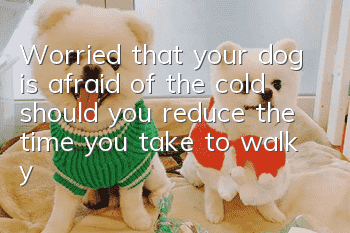Worried that your dog is afraid of the cold, should you reduce the time you take to walk your dog?

Outdoor exercise is a required course for dogs to stay healthy, but facing the magical attack of cold and humid air, dog owners are inevitably worried that their furry children will be frozen.
So, here comes the problem,
I am worried that my dog is afraid of the cold. Should I reduce the time I walk my dog or even not take him out?
A dog’s coat is their “real fur coat”, and some even have “double-layer quilting”. For example, the famous sled dogs have a thick and thick undercoat under their long hair, which can help resist common low temperatures.
In addition to dogs with thick coats that are very cold-resistant, dogs with dark coats are more cold-resistant than light-colored dogs. Larger dogs are more cold-resistant, and their youth are more cold-resistant than puppies and elderly dogs.
Therefore, for the above-mentioned dogs, only those who want to reduce the time of walking around are not willing to spend more time playing outside.
Secondly, the heat generated by walking the dog can cope with low temperatures
Taking your dog for a walk is actually the simplest form of exercise.
Similar to walking on two legs, if a certain amount of exercise is reached, the dog's body will generate heat.
Theoretically, if your dog is very active outdoors, it can generate enough heat to cope with the cold.
However, fellow scrappers cannot take it lightly.
Specific analysis of specific dogs. Whether a dog is afraid of the cold is also related to many other factors such as the acquired living environment.
Whether the time spent walking the dog should be reduced should not be judged by our own feelings, but by the following behaviors of the dog:
-When we go out in cold weather, the dog suddenly trembles non-stop
-The dog kept whining during the walk
-The dog suddenly acts anxious or raises one or more paws
-The dog’s movements become slow and the soles of its feet are too cold
If any of the above situations occur to your dog, it means that you have an owner who is afraid of the cold, and is really not suitable to continue "going out on patrol" and needs to retreat in time.
For these dogs, all poop scavengers can remember these six-word mantra: dry them frequently and frequently.
Multiple frequencies
In winter, taking into account the outdoor environmental conditions and the dog's own age and physical condition, the dog walking method can be appropriately adjusted, such as using short distance, short time, and multiple frequency methods.This method replaces the previous long distance and long time method.
This will not reduce the amount of exercise, but will help improve the dog's ability to adapt to cold weather.
Wipe dry frequently
If you take your dog out in winter, you must keep your body dry when you come back, otherwise it will easily cause your dog to catch a cold.
At the same time, snow and ice often contain calcium chloride salt, which will adhere to the toes of dogs after going out for a walk. If the dog eats it while licking its feet, it can easily cause vomiting and diarrhea. Therefore, after going out in ice and snow and returning home, clean your dog’s toes first.
If the dog is not particularly afraid of the cold and yearns for the outdoors. So, fellow poop shovelers, put on your clothes, hold up the rope, and take your furry children to have fun in the snow!
- Dog suddenly licks things frequently
- How many hours of sleep do dogs need a day?
- What should I do if my Chinese Shar-Pei has diarrhea after eating too much?
- Is 84 disinfectant harmful to dogs?
- Basenji and Corgi Crossbreed_Pictures
- Dog oral care tips
- How to train Tibetan Mastiff to be obedient and what to pay attention to when training Tibetan Mastiff
- What are the symptoms of Chow Chow cold?
- What are the symptoms of a dog’s menstrual period?
- What problems should be prevented when raising a Chow Chow?



